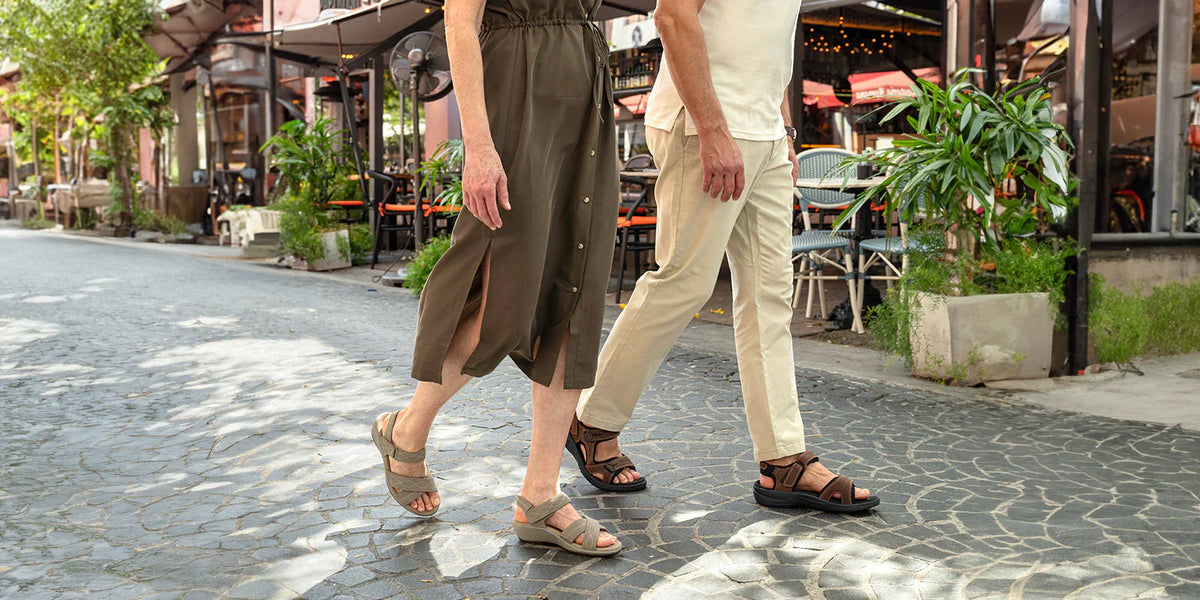The Orthofeet Blog
- All Posts
- All
- Arch Support
- Back Pain
- Bunion
- Diabetes
- Flat Feet
- Foot Pain
- Heel Pain
- Heel Spurs
- Hip Pain
- Knee Pain
- Plantar Fasciitis
- Swollen Feet

Vincent Lin / October 21, 2025
Can Stress Cause Burning Feet? Understanding the Connection
Can Stress Cause Burning Feet? Understanding the Connection
Read Post
Popular Articles
EXPERT CONTRIBUTORS
-
Best 7 Shoes for Standing All Day Comfortably for Men and Women
Medical information provided by Orthofeet Team / June 06, 2025When you work long hours or simply spend most of your day on your feet, you come to expect foot pain and discomfort as an inevitable consequence. But, when this foot pain starts to interfere with how well you work and prevents you from going about your daily activities, you need a better solution that can protect your feet from the pain that results from standing for long hours. When people start to feel pain or avoid certain activities, they often blame themselves, the activity, the intensity at which it was performed, or even the environment. However, they tend to overlook the item that is directly related to their pain and that is the type of shoes they wear. If you feel foot pain after spending long hours on your feet, start by looking at your shoes. Most probably, they are either too small and narrow, not designed with the necessary features to keep you pain-free, or both. What are the best shoes for standing on your feet all day? Here are the design features you should look for in shoes that are recommended for people who stand all day. Orthotic support is crucial for protecting your feet from long hours spent standing. Orthotic insoles support the arch, cradle the heel and provide the best chances for keeping your feet in line with the rest of the body. Basically, with the right orthotic support, you will feel like you’re standing on a cloud, even when the surface under your feet is concrete. They also guarantee a comfortable fit, but most importantly will prevent injuries and new foot conditions from developing. Superior cushioning made from unique materials that provide the very best shock absorption and comfort. This includes insoles made from foam that conforms to your foot shape for a truly customized fit and comfort. The placement of the materials is also important, with more cushioning needed in the heel and around the metatarsal heads. Upper materials that stretch are an important feature because they provide the necessary give when your feet swell while relieving any further pressure on the foot. Supple leather is also a good material to look for in a shoe, as it provides more stability and durability. Shoes with soles designed to facilitate foot motion. A minimal heel-to-toe drop and mild rocker soles are the best, as they prevent the transfer of weight to the forefoot area, which can cause pressure on the foot. Adjustability. Why? A truly comfortable fit depends on finding the right shoe for your foot size, width, and shape. No two feet are the same! Shoes with adjustable features from hook and loop straps, to laces, bungee cords, and zippers allow the wearer to adjust the fit of the shoe to their particular needs, while also ensuring a secure fit and stability. Wide widths are geared for people with feet that are not the standard medium (B), which is what most footwear companies manufacture. Having a choice in width availability ensures the wearer finds a shoe that fits their foot shape the best. Only shoes that come in varying widths can do this. Wide widths are also helpful when it comes to preventing swelling in the feet. With that in mind, here is our list of the best 7 shoes for prolonged standing. They are all designed with the features listed above, yet each shoe has its own unique qualities. Best Walking Sneakers Men's Edgewater | Women's Coral [product-tile="/products/coral-black"] Their highlight stretch uppers are perfect for long days on your feet, as both shoes stretch and really take the shape of your foot, accommodating potential foot swelling, as well as large bunions and hammertoes. The fabric uppers coupled with the soft, ultra-padded interiors, which are also seam free, make them comfortable for a long day spent standing and perfect for sensitive feet. These shoes can fit almost any size and foot shape, as they are available from a medium to extra extra wide width (6E for men, 4E for women). If you need to free up even more room to insert a custom orthotic or braces, the insole can be removed easily. They are available in plenty of colors to suit any season and outfit. Best Working Boots Men’s Granite [product-tile="/products/granite-camel-work-boots"] They may look like regular work boots, but the Granite boots are fully orthopedic, which means that even though you spend long hours on your feet you won’t experience pain during or at the end of the day. The upper is designed with waterproof leather , sealed seams and a gusseted tongue to prevent any liquids from seeping in, while the rubber outsole is slip resistant even on oily surfaces. There is even a neat ladder grab feature on the sole with notches that help catch ladder steps for greater stability. These shoes are also impact, compression and electrical hazard resistant. Available in widths ranging from Standard (D) to Extra Wide. Best shoes for standing all day on concrete Men’s Cobalt| Women’s Moravia [product-tile="/products/moravia-waterproof-black"] The waterproof uppers of the Moravia women’s shoes make sure your feet are dry, while the extra roomy toe box will allow your toes to spread out comfortably. The men’s Cobalt work shoes are also constructed with a durable upper, made from non-abrasive high density fabric to take you through the toughest and messiest days on your feet Similar to Moravia, the Cobalt boots also have a roomy toe box, with the added feature of composite safety toe to protect your feet. Although they have increased safety features, they are super lightweight compared to others, thanks to the unique materials and ergonomic rocker bottom sole. The rubber outsole of the Cobalt work boots is slip resistant, while the outsole of the Moravia shoe offers advanced grip and superior stability. Both shoes are designed with a cushioning insole that works wonders to reduce fatigue and alleviate stress on your feet and legs. In addition, the soft, seam free padded interiors in both styles will eliminate any irritation and feel comfortable against the skin. The shoes are available in widths ranging from Medium to Extra Wide. Best Shoes for Nurses Men's Lava | Women's Francis [product-tile="/products/lava-no-tie-black"] For a healthcare professional that stands all day, the right shoes can make all the difference between a good shift and an unbearable one. To start, the no-tie bungee lace closure of the men’s Lava and women’s Francis sneakers is both fully adjustable and allows you to slip in and out of them easily and quickly. Both shoes are constructed with a special rubber sole and tread design that provides increased traction and grip on any surface, which is extremely important for settings that deal with spilling liquids. Thanks to their unique materials, both shoes are breathable and allow air flow to circulate and keep your feet healthy, while the removable orthotic insole is made with a breathable, soft top cover that wicks away moisture. The air pocket under the heel and foam cushioning under the foot will make you feel like you're walking (or standing) on a cloud. And finally, both shoes are designed with a lightweight ergonomic sole that makes them super light on your feet. Available in extended widths ranging from narrow up to extra extra wide. Why do your feet hurt after standing for a long time Even when you stand still, your feet and leg muscles continue to work because they need to constantly adjust to the surface so that your body keeps its balance and stability. This may surprise you, but standing still can actually be harder on the legs and feet than moving around or walking. Since the muscles never get a break - compared to walking, for example, where the muscles get some rest as the legs alternate - this specific muscle function can cause significant foot and leg fatigue. In addition, when you stand in one spot for prolonged periods it interferes with the ability of the blood to move back up the legs after delivering oxygen to the feet. The blood starts to pool in the feet and lower legs, causing swelling and pressure on the tissues. The strain on the muscles, swelling, and pressure on surrounding tissues are the reasons you feel pain after prolonged standing. How to protect your feet while standing at work There are a few tricks you can try to prevent or decrease the effects of prolonged standing. Shift your weight from one foot to the other to give your muscles some rest. Place one foot on a small stool and alternate your feet, to distribute the weight load on the legs. Wear compression socks to improve blood circulation in your feet and legs. Wear supportive shoes, preferably with orthotics, to help align the feet, legs, and body, so that the leg and foot muscles don’t have to work so hard. How do you keep your feet from hurting when standing on concrete? Concrete and other hard surfaces can put pressure on the foot and especially the plantar fascia - the ligament that supports the muscles and arch, and runs under the arch, connecting the heel bone with the base of the toes - causing it to swell, which can cause heel pain. Throw in the painful effects of prolonged standing and you have the perfect recipe for significant foot and leg pain. The problem with your current shoes There can be several reasons why your current shoes aren’t providing the comfort you need for long days on your feet. They flex too much, or not in the right places. A shoe that flexes where the foot won't, or a foot that needs to flex where the shoe doesn’t, is a recipe for disaster in terms of both immediate and future foot problems. You need a shoe that flexes with your foot in all the right places, but not too much. If you can twist the shoe or do a 90-degree bend, then it probably doesn’t have enough support. A shoe that flexes in the right place supports the natural movement of the foot, making it easier to walk while providing adequate motion control. They are too rigid. Support is important, but a shoe that is too rigid in the sole or upper can lead to blisters, excessive swelling, bursitis and pain in the achilles tendon. A shoe that is rigid will make walking more difficult and overwork the joints and muscles, and that can ultimately lead to injuries. Flexibility and support are crucial. No orthotic footbed. Shoes with just a flat insert are not going to provide the necessary support and cushioning needed for long days on your feet. Only an orthopedic insole will support the arch and relieve potentially painful stress on the foot. Orthotic inserts will also align the body and help you stand (and walk) without your ankles and feet rolling inwards. Upper materials. Shoe uppers made from inadequate materials that don’t hold the foot in place, and ones that aren’t able to stretch with your foot, will only add more pressure to the feet and cause discomfort, pain, and potential foot problems. You need a shoe that is designed with materials that will provide stability but will also be flexible enough to accommodate swelling after long hours on your feet. Opt for flexible materials such as fabrics or soft leathers that will conform to your foot shape. The wrong width. A narrow width and pointy shape will cram your foot and especially your toes into a space that is just too small for them, meaning increased pressure on the feet. This can lead to bunions, hammertoes, corns, and calluses, and also aggravate existing foot conditions. When your toes don't sit in the proper position, they also don't function as they should, which translates to issues with gait (the way you walk). Shoes with a wide toe box that is also round in shape provide the most comfortable fit. Materials that don't promote breathability. If your shoes aren’t constructed from the right materials they won’t provide the adequate airflow your feet need and without that cooling effect, sweating becomes an issue. Sweaty feet can lead to odor, bacteria, and fungus, which can aggravate and contribute to future foot issues. Shoes that breathe are critical for long hours spent on your feet, both for foot health and comfort at the moment.Read More -
Wide Width Shoes - The Essential Guide
Medical information provided by Orthofeet Team / June 06, 2025Wearing shoes that are too narrow for your feet can not only be extremely uncomfortable and painful, but also cause unpleasant foot conditions, such as ingrown toenails, corns, calluses, and metatarsalgia, or worsen existing ones, such as bunions and hammertoes. To address these issues, consider exploring options like the best shoes for Morton's neuroma, which are designed to relieve nerve pain in the ball of the foot. Additionally, for those suffering from skin irritations, finding the best shoes for corns and calluses can help reduce the pressure that exacerbates these conditions. If you experience pain in the ball of your foot, it might be beneficial to look into the shoes for metatarsalgia, specifically tailored to alleviate this type of pain. Moreover, learning how to prevent bunions is essential for those with narrow footwear that could lead to or worsen foot deformities. If you’re experiencing any of these issues, switching to wide, extra wide, or even extra extra wide shoe sizes can offer substantial relief and comfort. However, finding wide fit shoes can be challenging, as most footwear is designed for the average foot, which typically fits a medium width. While medium width shoes are readily available at conventional shoe stores and through online brands, wider options often require shopping at orthopedic shoe companies or specialty footwear brands. These companies, such as Orthofeet, specialize in designing and developing shoes such as wide shoes for men and women’s wide shoes. What Are Wide Shoes? Wide width shoes are a wider version of standard sized shoes, with wider than normal features, such as a toe box that gives the toes plenty of room. Normally, these shoes are also different all around, including girth, straps, special laces and so on. With a wider toe box, the toes of individuals with wide feet can naturally spread out as they walk, preventing the painful pinching sensation that is common when you wear shoes that are too narrow for your feet. Good wide width shoes also tend to be deeper and are wider from the front to back, not just in the forefoot, since usually, wide feet are also taller than the standard. This means that if they are designed with straps or laces, these features will be longer than usual to accommodate the increased girth. What’s Considered A Wide Foot? If your feet feel uncomfortable in most shoes, even the ones that are not particularly narrow, you may be wearing the wrong width. So, the most obvious sign that your feet are on the wider side is quite simple: your feet feel squeezed-in in every pair of shoes you wear, even when the fit of the length is perfect. Some may try to move on to longer length shoes, but, although these could provide a bit more room for the toes, shoe length that doesn't fit right at the heel or toe box could result in slippage that leads to trips and falls, and cause blisters and other issues. How To Know If You Have Wide Feet? Ideally, the best way to determine if your feet are wide would be to measure them, but unfortunately there is no universal width measurement chart that would allow you determine what width you need from any shoe brand. Our suggestion, while simple and unsophisticated, is to determine if your current shoe width is too tight for you. For example, if you purchased from a mainstream brand, it is likely your width is a B (standard). You can verify this by looking inside the shoe, on the tongue or side of the upper. If you feel your feet are being squeezed in, you need to go up in width, so a wide would be the next width up and so forth. Luckily, many online shoe retailers have friendly shipping and return policies that allow exchanges if the fit is not good. How is width measured? There are three factors taken into consideration that determines shoe width: the length of the foot. the measurement between the widest points on the foot, i.e., the outer edge of the foot to the inner edge of the forefoot area (known as ball width). the circumference of the instep (known as instep girth). Wide width shoes are wider across the shoe, deeper from top to bottom, roomier in the toe box area, and have a generous instep to accommodate wide shoes for swollen feet. Shop Women's Wide Shoes Shop Men's Wide Shoes Whereas medium-width shoes often don’t include a width label, wide-width shoes come with a label indicating their width. Therapeutic shoes or orthopedic shoes such as Orthofeet shoes, are available in wider widths, and the width is designated by letters. The letters differ for men and women since men’s feet tend to be larger and wider than women’s feet. Normally a wide width shoe for women is indicated with the letter D; for men a wide width shoe is indicated with 2E. Women’s Extra-wide shoes for women are indicated with 2E and for men an extra wide width shoe is indicated with 4E. For most people requiring wider shoes, a wider shoe at the ball- of-the-foot and toe-box is most important. When measured at the ball-of-the-foot, the difference between shoe widths is approximately 1/4”. A wide width is 1/4” wider than a medium width and an extra wide width is 1/2” wider than a medium width. People with foot swelling or edema symptoms may benefit from additionally measuring their instep girth, which will help them choose the appropriate shoe width. In general, the instep girth of the shoe increases 3/16” for every increase in width for the same length. B width This is the medium width for women and considered the “standard” one. Almost all the shoes you find in the retail store or online sites are this width. For men, this width is considered narrow. D width Normally, a wide width shoe for women is indicated with the letter D, while it’s considered medium for men. E width E describes a wide width shoe for men and extra wide shoe for women. EE width The more ‘E’s you add the wider the shoe, so EE, or 2E is a wide shoe for men and extra wide for women. Visit the shoe sizing chart for a complete list of the different width sizes for men and women. How to find comfortable wide-width shoes There are important features to look for in comfortable wide shoes to ensure that they fit properly, and provide comfort, support and pain relief, such as the ones found at Orthofeet's orthotic shoes. The extra depth design and the roomy toe-box area provides extra room for toe movement and a comfortable, non-binding fit. Included with every pair of shoes are two sets of removable spacers that allow you to adjust the space inside the shoe for a perfect fit. Stretchable materials allow the uppers to perfectly form to the contours of the foot offering a loose, customized fit and easing pressure on bunions and hammertoes. One of the biggest challenges faced when searching for a good pair of wide width shoes is finding a pair that is stylish as well as comfortable, as there are usually limited style options for comfortable dress shoes for wide feet. Luckily, there are orthopedic shoe brands that offer wide width shoes without compromising on style, whether you’re looking for the best wide width shoes for women or for men. [product-group-tile] FAQ Can I wear wide fit shoes if I have a normal foot width? If you’re comfortable wearing wide width shoes even though your feet are standard width, then it’s not an issue. In fact, wearing wide width shoes with normal feet can sometimes be more comfortable when you go on long walks. But, whether or not it’s a good idea to wear wide width shoes with standard feet depends not only on comfort, but also on the activities you’re planning to engage in. For example, it is not advised for individuals with normal foot width to wear wide width shoes if they’re participating in sports activities, because it could cause falls, muscle pain, blisters and other foot problems. In addition, if your shoes are too wide it’s best to avoid walking and running on slippery or uneven surfaces, because your feet may slip inside the shoe, leading to loss of balance and falls. Regular-fit shoes would be the better choice in such instances, simply because they hold your feet better. Does a wide shoe make a difference? If you have wider feet then the answer is very clear: Yes! Squeezing a wide foot into a narrow shoe can not only be uncomfortable and painful, but also cut off the blood circulation in your feet, causing foot pain as well as a long list of foot problems. With wide width shoes you can give your feet both the space and the support they need and allow the foot to function properly. Are wide shoes better for flat feet? Unless your flat feet are narrow, many people with flat feet can benefit from wide width shoes and should avoid shoes with a narrow forefoot. As people with flat feet tend to apply more pressure on the toe area, with more room for the toes, wide shoes can help prevent toe cramping. For those seeking the right shoe for various needs, whether it's a walking shoe, an athletic shoes, or even a running shoe for more active lifestyles, choosing footwear that accommodates the widest part of your foot is crucial. This ensures not only comfort but also helps in managing conditions like hammer toes, heel pain, or any other foot condition. When looking for the perfect shoe, consider the unique needs of your feet to ensure optimal comfort and function. Here are our Top 5 recommendations for wide width shoes Edgewater Stretch Knit [product-tile="/products/edgewater-stretch-blue"] Why It's Great: The Edgewater Stretch Knit shoe is perfect for those with wide feet because of its stretchable knit fabric, providing a customized fit without feeling tight. It has a non-binding upper construction that reduces pressure on the foot, ideal for people with conditions like bunions, hammertoes, or swollen feet. Key Features: Extra-depth design, ergonomic sole for comfort, premium orthotic insoles with anatomical arch support, and excellent cushioning. Coral Stretch Knit Athletic Shoe [product-tile="/products/coral-stretch-knit-lavender"] Why It's Great: The Coral Stretch Knit Athletic Shoe provides a combination of width, support, and comfort. Its stretchy upper conforms to the foot’s shape, ensuring a perfect fit, and the wide toe box offers more room, reducing pressure on the forefoot, beneficial for conditions like Morton’s neuroma or arthritis. Key Features: Lightweight sole with advanced air cushioning, wide toe box for ample room, and removable insoles for orthotic customization. Naya Stretch Knit [product-tile="/products/naya-hands-free-blue"] Why It's Great: The Naya Stretch Knit Mary Jane is designed for women who need both style and comfort in a wide shoe. Its stretchy knit upper and adjustable strap provide a perfect fit while reducing foot pain caused by pressure or friction. This makes it an excellent choice for people with bunions or swelling. Key Features: Stretchable upper, wide toe box, padded interior, and orthotic insoles for enhanced arch support and comfort. Pierre Men’s Casual Shoe [product-tile="/products/pierre-hands-free-black"] Why It's Great: The Pierre Men’s Casual Shoe is perfect for those who need a wide, formal shoe that maintains comfort. The shoe's soft, padded interior and wide, deep toe box offer a roomy fit that alleviates pressure points, which is great for long days on your feet. Key Features: BioFit orthotic insoles, extra depth design, non-binding upper, and ergonomic sole for cushioning and shock absorption. Hunter Men’s Hiking Boot [product-tile="/products/hunter-brown"] Why It's Great: For individuals with wide feet who need durable outdoor footwear, the Hunter Men’s Hiking Boot offers excellent support and a comfortable wide fit. The boot’s wide toe box provides plenty of space for toes, reducing pressure and discomfort on long hikes. Key Features: Waterproof design, orthotic insoles with arch support, cushioned sole for impact absorption, and available in multiple widths for a custom fit.Read More





